Curses: Polo Cutback in Connecticut
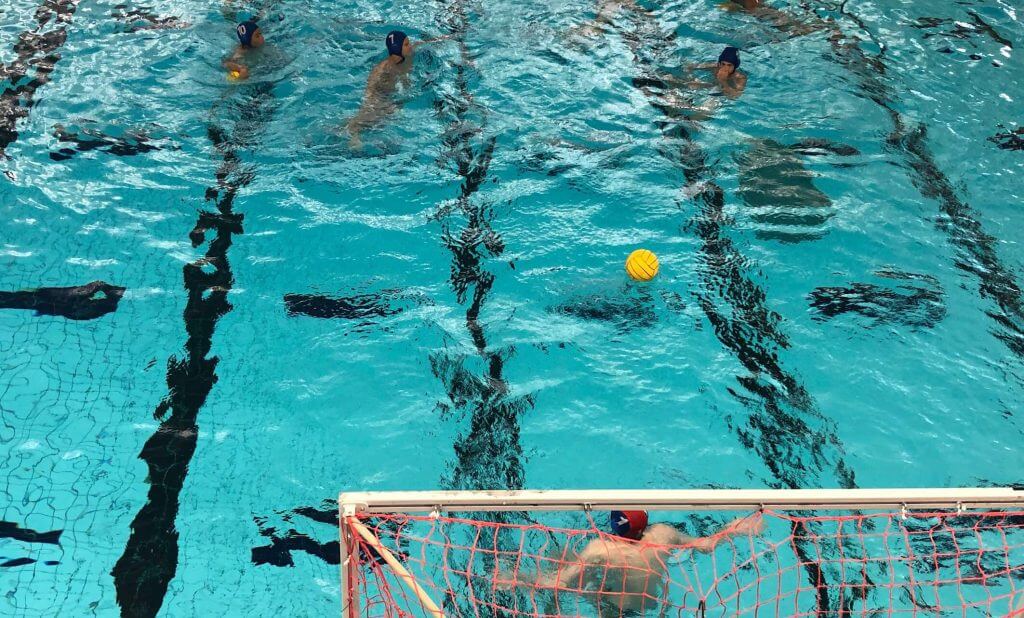
Three ingredients are necessary for successful water polo programs: coaches, athletes and pool time. Especially pool time. No polo or swim program can exist without consistent access to a pool.
Which is what makes the apparent failure of the Chelsea Piers age group water polo program baffling; they had strong coaching, a deep talent base from which to recruit, and access to the finest aquatics venue in the Northeast.
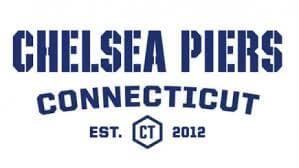 Now, while the coronavirus crisis rages throughout the country, the program’s parent company has taken the opportunity to cut the program.
Now, while the coronavirus crisis rages throughout the country, the program’s parent company has taken the opportunity to cut the program.
“Due to the COVID-19 crisis and the economic challenges most businesses are facing, we have had to take a very close look at all of our lines of business and make some hard decisions,” said Greta Wagner, CEO of Chelsea Piers Connecticut (CPCT)in a statement. “One of these decisions is that Chelsea Piers Connecticut will be discontinuing the water polo program.”
This unfortunate development, though, is not due solely to the pandemic. It’s an outcome for a program that has been declining for some time, the byproduct of a nasty split a decade ago with parents from Greenwich whose program has come to dominate the region.
But the move by CPCT to sever ties with Paul and Jimmy Ramaley—the age group club’s primary coaches—has empowered a group of determined parents and supporters, led by Scott Schulte, to reverse a change in fortune for a club that was once the East’s best.
A program hardened by adversity
The origins of the Chelsea Piers program in Connecticut date back almost forty years, when Terry Lowe, a venerated swimming and water polo coach based in Greenwich, began cultivating the sport in Fairfield County. Greenwich Water Polo Club was the result of years of effort by Lowe and others to meld numerous country club summer programs into a regional program able to compete throughout the East as well as at USA Water Polo’s national Junior Olympics tournament (JOs).
Based at Greenwich High School, Lowe and his assistants scoured the county for pool time, forced to use different locations for practice.
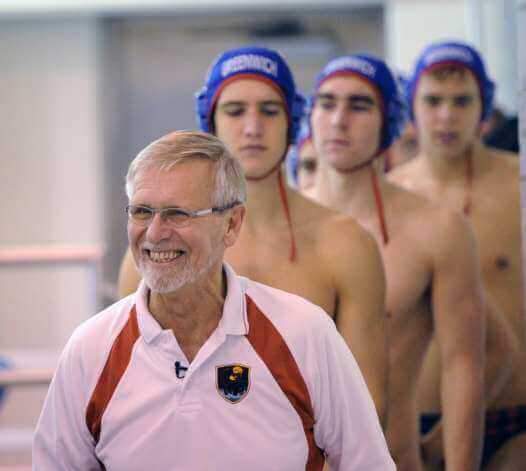
Terry Lowe in 2013 with Greenwich High School. Photo: Bob Luckey
Then, in 2010, the Chelsea Piers Corporation touted their highly successful operation on the Manhattan piers in a proposal to create a 400,000 square foot sports and recreation venue that would include a 50-meter, Olympic-sized pool with moveable bulkhead. Based on the site of a former Clairol factory in Stamford, it seemed the ideal solution for Lowe’s wandering club.
“To have a true ‘home pool’ instead of always being on the move—in the past we used up to five pools to run our program in whatever hours we could sneak out in those pools,” Lowe said in a recent interview. “We were delighted to have a new facility open up where the program could have a home base in which to operate.”
Nathaniel Miller, a former Canadian Olympian, was the head coach when the new location opened in 2012. He left after a year, and Paul Ramaley—who played for Lowe at Greenwich High School as well as in college at Johns Hopkins—was installed to run the age group program, now branded with its new sponsor’s identity.
The transition to the new facility was not entirely smooth. A group of influential polo parents, including Bill Smith, one of the region’s leading advocates for the sport, chose to break away and form a partnership with the YMCA in Greenwich.
Smith, a board member for USA Water Polo, has invested considerable time, talent and treasure in Greenwich Aquatics; not only has this program grown to be the dominant age group club on the East Coast, it has gradually siphoned off talent in the region, including from the Chelsea Piers program.
Listed as a technical advisor to Greenwich Aquatics, Smith and his wife Kathy made a generous gift that enabled the Y to build one of Connecticut’s better pools. He looked back, a little ruefully, at the challenges his former program now faces.
“[W]earing my USA Water Polo hat, there is nothing good about not having the Chelsea Piers program,” Smith said last week. “Clearly there are some players who will be moving over to Greenwich Aquatics, and it’s abandoned athletes looking for a home.
“This isn’t anything that Greenwich Aquatics wants, looks forward to or relishes that we get some wonderful athletes who were at Chelsea Piers,” he added. ”That’s not even on the table.”
Over the past decade, the rivalry between the two programs has been heated. Drawing on its years of success and experience, Chelsea Piers dominated early. But, due to support from some of the wealthy county’s most affluent families, as well as the astute leadership of Smith, program director Kim Tierney-Wang and head coach Ulmis Iordache, Greenwich Aquatics has emerged as the region’s strongest program, growing to an approximate membership of 300.
A spokesman for Chelsea Piers Connecticut (CPCT) confirmed that, this spring, less than 30 athletes were registered in their polo program.
Out of the ashes a new club will rise?
Losing the umbrella support of Chelsea Piers corporate presents a huge challenge for Coach Ramaley and the parents who support his program. But, notes Ramaley, the hardship need not be terminal. In fact, it’s possible that this change may prove cathartic, revitalizing a club that has been struggling with recruitment for some time.
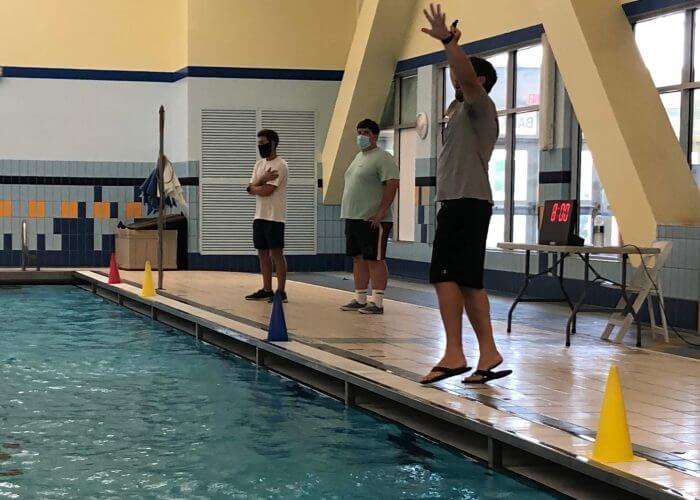
Paul Ramaley coaching at Chelsea Piers last Sunday. Photo Courtesy: M. Randazzo
“We have always been a strong club competitively, but we need to get those younger kids in the program and sustain it from there,” Ramaley said in an interview last week. “We have to be creative in how we market—which, moving from Chelsea Piers, may make it better.
“This might be a chance for us to reach out to places that haven’t had water polo before and build from there.”
According to Susan Miller, whose daughter Olivia has played with the club off and on for the past couple of years, select parents, including John Bradbury and Jennifer Lewis, are prepared to pick up the slack.
“The bigger story is the spirit and resilience of the parent board and coaches and how quickly they picked up and turned the whole thing around,” she said in an email describing a new practice schedule that started mid-July.
Scott Schulte, a former college standout with Bucknell who now lives in New Canaan, has been enlisted to help reboot the program. He will lead a reconstituted parent board, one that will replace CPCT as the club’s chief decision-maker.
“What this pandemic has done, and what’s happened at Chelsea Piers is a blessing in disguise,” Schulte said in a recent phone conversation. “It created an opportunity to reevaluate the challenges that were taking place at Chelsea Piers—which will now change its name.”
A successor program, tentatively renamed Connecticut Premiere Water Polo Club, will not only serve the Greenwich area that previously was the club’s main population base. According to Schulte, they will draw in new athletes from all over the Nutmeg State as well as surrounding New York and Massachusetts.
Ramaley has already secured pool time from his former employers. The arrangement is not as favorable as previously, but the club will be able to practice as often as four times a week. This is no small consideration–—due to the virus, many states have closed down indoor swimming and recreation facilities. Connecticut is not among that group, which allows the club to potentially draw in new members as surrounding states like New York struggle for pool time.
Despite some defections, the core talent for older age groups has stayed put, including Jack Merrill, a prep school player who is one of the top 16U polo athletes in the East. In 2019 he was selected for the Canadian Youth National Team that competed in the UANA Youth Pan American Water Polo Championships.
It will be imperative that Schulte and Ramaley retain older talents while building depth from the bottom up. Jimmy Ramaley, head boys coach at Greenwich High School, can also help retain some of Connecticut’s best high school players.
Chelsea Piers an indispensable factor
There’s also the issue of access to the Chelsea Piers facility for regional competition. One of the best pools on the East Coast, CPCT has hosted Tri-State league play, a regional tournament for 12U, 14U and 16U athletes, as well as regional qualification tournaments for USA Water Polo’s JOs.
According to Ken Vincent, an age group coach who leads the Buxmount program in Pennsylvania, the potential facility loss is as big a story as the challenges faced by the club.
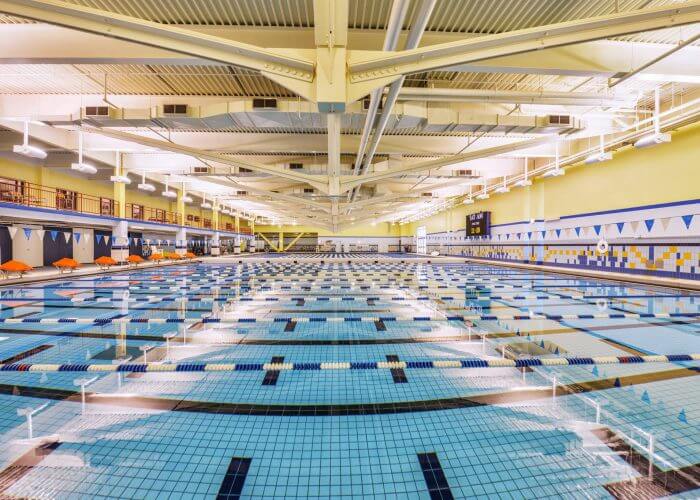
One of the East’s best pools. Photo Courtesy: Chelsea Piers Connecticut
“Chelsea Piers is a critical venue for Northeast Zone water polo and the development of additional water polo in the Northeast,” he said recently. “We have always looked at Chelsea Piers and a couple of others—stakeholder facility and programs throughout the Northeast—to be a focal point for development of new teams and programs.”
Smith, whose Greenwich Aquatics program is another of the “stakeholder programs” that Vincent alluded to, has seen his club come through the coronavirus crisis intact. He acknowledged that, as both a rival and an important support for polo’s growth in the region, the Chelsea Piers program was far more than a just a polo club.
“People say [that] the most obvious thing is they’re losing the pool,” he commented. “It’s more than that. We’re losing a wonderful program. The only way we can grow on the East Coast or other spots is to have great competition.
“If you look at where there’s thriving competition—in California, they can have high-level games, three or four a week. If you’re a top-flight team, unless you’re playing your best you’re going to lose the game…. You want to have top-flight competition.”
Going back to its roots
Ramaley, who grew up with Greenwich polo, remains committed to a program that reflects the roots of the program that he’s known much of his life.
“We will be an independent program, like most of the clubs on the East Coast—a non-profit based club,” he said. “We’re operating on a day-to-day basis; finding pools, which I know a lot of clubs in New York City have to deal with, that grind of finding pools to rent.”
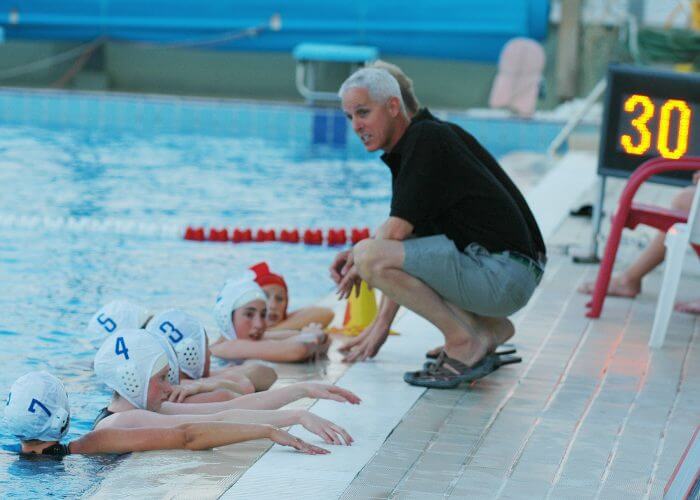
Bill Smith. Photo Courtesy: B. Smith
This will present challenges, but Smith and Lowe, once united in the Greenwich program and rivals thereafter, both agree that there’s more than enough talent to be tapped from the toney world of Connecticut high schools and country clubs.
“For me or anyone to say that we’ve peaked … there’s tremendous opportunities [here],” said Smith. “Two things you need to grow are coaches and pool time. Local clubs encompass both of those. Losing a club like Chelsea Piers is bad on both fronts. We want to have more clubs and more kids at a higher level.”
Lowe agrees that demand exists, but for the sport to thrive, competition is key—meaning that Greenwich Aquatics and the former Chelsea Piers program must be strong…again.
“[B]oth programs are going to say we want a strong, independent program and we’re not going to be leeching off each other to do that,” said Lowe. “The vibrancy of polo in this area is really dependent on those two programs existing and maintaining some sort of competitive balance.
“Other than that, it’s travel all the time.”



